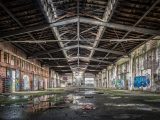The house was renamed Strathmore Hall, after the newly established nonprofit, and the Mansion with its surrounding grounds were developed as Montgomery County’s first center for the arts. After extensive restoration, the Mansion at Strathmore opened its doors to the public on June 24, 1983. The concert hall was designed in the traditional “shoebox” form of many international concert halls.
- The Washington Performing Arts and other world music performance groups perform throughout the year.
- Strathmore is a premier art institution of the region, hosting more than two dozen exhibitions a year.
- The public-private partnership between Strathmore Hall Foundation, Inc. assumes the day-to-day management and artistic programming of the Music Center and Mansion.
- Inspired by the rolling hills of the Strathmore grounds, the 190,000-square-foot (18,000 m2) building is nestled into an 11-acre (45,000 m2) park-like setting.
The Mansion was bustling with energy and many of Strathmore’s most enduring offerings—including intimate concerts in the Music Room, Afternoon Tea, visual arts exhibitions, and wedding venue—began during this time. Read on to trace the history of the Mansion at Strathmore, from its turn-of-the-century roots as a grand summer estate to its transformation into a spirited arts center. The Mansion at Strathmore is home to intimate artistic programs presented by Strathmore.
Artist in Residence (AIR) Program
The Music Center at Strathmore and the Strathmore Mansion are located at 5301 Tuckerman Lane in North Bethesda, Maryland, just off of the Capital Beltway and adjacent to the Grosvenor/Strathmore stop on the Washington, DC Metro’s Red Line. Take the stairs or elevators to the 4th level and walk across the sky bridge to the Concert Hall. Located on the Bou Family Terrace, “Tetra Con Brio,” a monumental sculpture of cast bronze, steel, and polished concrete, stands 12 feet (3.7 m) tall and weighs 4,500 pounds. In 1998, the Montgomery County Council and the Maryland State Legislature approved matching capital support ($48 million each) for the Music Center at Strathmore. After the design team was selected in 2001, work began under the direction of the county. In 1977, the Sisters of the Holy Cross sold the mansion to the American Speech and Hearing Association (ASHA) as a temporary headquarters.
Enjoy a concert in the acoustically superb Music Room, explore our galleries and current exhibitions, indulge in Afternoon Tea, stroll through the sculpture gardens, and find a special something at the Shop at Strathmore. In 1908, The Oysters sold the house and 99 adjoining acres to Charles and Hattie Corby. The Corby family enjoyed the house as a summer retreat until 1912, when they contracted Charles Barton Keen to make extensive modifications. Known to locals as the “Corby Farm,” the grounds had a fully operational dairy farm, greenhouse complex, private golf course, and many other outbuildings. After Charles’ passing in 1926, Hattie Corby remained in the residence until she passed away in 1941.
On June 21, 1983, after major restoration of the facility, Strathmore opened its doors to the public. Land records show that in 1943, two parcels of the original Corby estate—including the Mansion—were conveyed to the sisters directing St. Mary’s Academy. In 1942, Filipino president Manuel L. Quezon used the Mansion to set up temporary governmental headquarters and World War II operations for the former Commonwealth of the Philippines. Strathmore is in the process of researching the history of the land that we occupy to ensure proper acknowledgment of those who were here before us.
Strathmore Music Center and Mansion in Maryland
Hundreds of donors stepped forward to help build, equip and sustain the operation of the Music Center. Ownership and usage of the land is not well-known until 1823 when a toll road was built to connect Georgetown and Frederick. One of the road’s tollgates was near the intersection now known as Strathmore Avenue. As shown on an 1879 map, local landowner Frank Ball operated a stagecoach station and blacksmith shop on his farm at this location.
More Related Articles
The property features a 250-seat music venue offering live performances including jazz, rock, folk, indie, and more. The concert hall opened in 2005 and was built on the 11-acre site of the Strathmore Mansion, a 19th-century home Review Strathmore House which had been owned by Montgomery County since 1981. For more than two decades, the Mansion at Strathmore has provided intimate artistic programs with its 100-seat Dorothy M. And Maurice C. Shapiro Music Room, the Gudelsky Gallery Suite exhibition spaces, the outdoor Gudelsky Concert Pavilion, and outdoor Sculpture Gardens. Built in 1902, the Mansion at Strathmore is home to intimate artistic programs presented by Strathmore including our Music in the Mansion and Artist in Residence concert series. Visitors can also explore our galleries and current exhibitions, indulge in Afternoon Tea, stroll through the sculpture gardens, and find a special something at the Shop at Strathmore.
The hallmark of the arts center is the Music Center at Strathmore, a 2,000-seat concert hall that brings world-class performances by major national artists including folk, blues, pop, jazz, show tunes, and classical music. The Music Center at Strathmore serves as the second home for the Baltimore Symphony Orchestra (BSO), providing top-notch acoustics for classical, pops, holiday and summer concerts. The Washington Performing Arts and other world music performance groups perform throughout the year. The Education Center provides rehearsal space and practice rooms for the Maryland Classic Youth Orchestra, CityDance Ensemble, and the Levine School of Music. In March 2015, Strathmore opened an additional performance and event space – AMP by Strathmore within Pike & Rose, the new mixed-use development located about one mile north of the Music Center on Rockville Pike.
Above the stage, a mechanized canopy of 43 individually controlled acrylic panels can be adjusted to fine-tune sound for clarity and reverberation. Tunable sound-absorbing curtains behind the bronze grilling and banners in the ceiling can be deployed out of sight to dampen or enliven the sound. The complex is thus accessible for patrons coming from Washington, D.C., as well as the northern part of Montgomery County, Maryland via the Metro rail system. Your generosity brings distinctive programming and renowned artists to Strathmore’s stages and galleries and ensures that everyone in our community can experience the joy and wonder of the arts. Today, the organization’s hallmark is the Music Center at Strathmore, with a 1,976-seat concert hall and education complex that debuted in 2005. Strathmore quickly established itself as an important new cultural resource—not just for Montgomery County, but for the entire Metro DC region.
A flagship program of Strathmore’s Institute for Artistic and Professional Development, the Artist in Residence (AIR) program4 was created more than a decade ago to support artists as they transition to professional careers. Strathmore Artists in Residence benefit from the support of mentor musicians, participate in professional development seminars, and are offered extensive performance opportunities throughout the 10-month program. The Education Center, located at the opposite end of the building, features four expansive rehearsal spaces, including a dance studio with a sprung floor and two rehearsal rooms with 40-foot (12 m) high ceilings. This wing of the building also features a children’s music classroom, a small two-story rehearsal room and nine solo and small group practice spaces.



